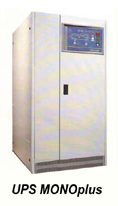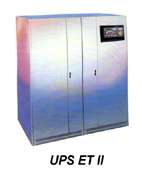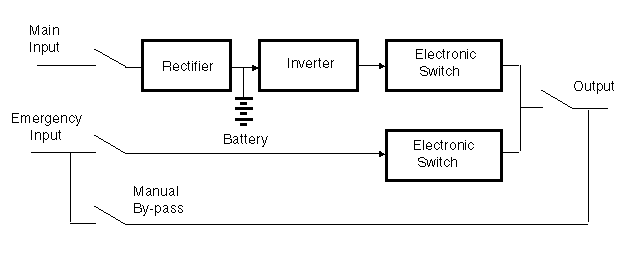



UNINTERRUPTED POWER SYSTEMS (UPS)
Adi Borri (Italy)
CPS Mono Plus - Compact Plus - ET II
MONOPHASE OR TRIPHASE OUTPUT
7.5 KVA to 350 KVA
UPS equipment brand ADI-BORRI, provide in their output a stabilized voltage of AC free of electrical noises for the supply of a determined consumption, which requires safe power for its correct operation.
UPS ADI-BORRI equipment generates the voltage of output of AC by means of an electronic invertor conformed by a circuit bridge to transistors operating in MWP (Modulation by Wide of Pulse) obtaining a sinusoidal signal with an output distorsion smaller than 3 %, a greater performance than 91 % at total load and a level of noise below 60dbA.
The stability of the output voltage is of + / - 1 % in any condition of load.
Whereas the stability of the frequency of the output voltage is of + / - 0,1.
The supply of the equipment is of 3 x 380 V being able its output to be monophase of 220 V or triphase 380 V and its frequency of output of 50 or 60 Hertz.
The invertor has electronic protection output against surge or short circuits.
All the equipment has a local electronic Control Panel in the frontal part, in this panel are the dials to visualize the state of operation of the different parts of the equipment and a digital indicator to observe the different variables from the equipment like voltage and output current, range, consumed power, etc.
In case of requiring remote information of operation of the equipment, it has an output to connect to a PC by means of a port series RS232, an output to connect a remote panel similar to which is in the front of the equipment by means of a port series RS485 and a card with relays for remote repetition of the alarms, by means of dry contacts and to connect themselves to a AS400 system .
All the components of the UPS equipment are mounted in a cabinet with hinged door in the front part, the side covers as the ceiling are detachable for a better access to the components of the equipment.
THE MAIN USES OF UPS ADI-BORRI EQUIPMENT ARE:
- Supply of the protective systems of generator plants and transformer stations
of electric power
- Supply of the control and security systems of plants of continuous process, such as
refineries, petroquimical plants, compressing gas plants, etc.
- Supply of communications phone systems, radiolinks of microwaves, or
satelite communications.
BLOCK DIAGRAM OF UPS EQUIPMENTS

RECTIFIER - BATTERY CHARGER
It delivers a voltage of DC from the voltage of AC to the UPS, by means a rectifying bridge to the tiristores, stabilizing the voltage of AC before variations of the voltage and the frequency of the line of supply and before variations of the input current to the invertor.
Simultaneously recharges the battery, which feed the invertor when a fault in the line of AC takes place.
INVERTOR
It generates a voltage of AC from the voltage of DC given by the rectifier or battery.
For this means it is provided with a group transistors in bridge configuration operating in MWP, an output transformer and a filter of AC, that allows to obtain a sinusoidal output signal, low distortion and with high performance.
ELECTRONIC SWITCH
The UPS equipment is provided with an electronic switch which allows, in case of necessity, to transfer the load of the equipment from the invertor output towards the emergency line that has the UPS.
It is to say that if the invertor fails to supply voltage due to the exhaustion of battery during a fault of the line of supply, the electronic switch will transfer the load towards the line of emegency if this is present and their values of voltage and frequency are within margins allowed by the system.
When normalizing itself the operation of the invertor, the electronic switch retransfers the load from the line of emergency towards the invertor.
All these transferences are made in smaller intervals than 1 ms in any condition of load.
For it the output of the invertor is synchronized with the line of emergency to avoid any transitory during the transferences.
INDIVIDUAL OPERATION OR IN PARALLEL
Depending on the requirements of the user, UPS ADI-BORRI can be used in three forms:
| Individual | A single equipment supplies the consumptions |
| | |
| Parallel - Hot Stand-By | Two equipments, one in synchronous operation and the other in stand-by working in phase and frequency |
| | |
| Redundant Parallel | Connection of several equipment in parallel, from 2 to 6 equipments, with distribution of the output current in balanced form. |
The UPS ADI-BORRI equipments, have the possibility to, with a minimal instalation, a single UPS with their corresponding bank of battery, and being able to make more extensions if in the future the necessities of the plant require to increase the power or the trustworthiness of the system, without carrying out modifications in the equipment.
In the case of needing to increase the trustworthiness of the system (Parallel Hot Stand-By), it will only be necessary to install an extra card in each equipment, and three cables of interconnection between them.
In the case of needing to increase the power of the system (Parallel Redundant), it will only be necessary to install an extra card in each one of the equipments, and three cables of interconnection between both, and also inductives in the output of each equipment.
ALARMS
| Failure of supply | When it lacks the supply voltage or when its value is outside the tolerance. |
| Rectifier Failure | When the rectifier lets give voltage by fault of supply, overloads or overheats |
| Low battery | When during a discharge of battery the voltage diminishes below 360 Vcc |
| Failure of the invertor | When the invertor lets give voltage due to: low voltage of DC, output voltage outside limits, overheating, failure of some of the output transistors. |
| Failure of the line of emergency | When the voltage and/or the frequency are outside tolerance, f.e. when the equipment is fed by a G.E. whose voltage and frequency on output varies according to load |
| Load supplied by the line of emegency | When the invertor has stopped its operation and the electronic switch has transferred the load to the line of emergency |